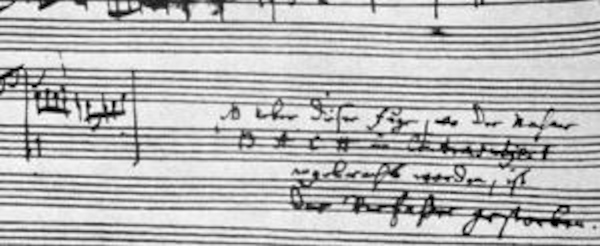Introduction
“Über dieser Fuge…”
Structure of The Art of Fugue
The “unfinished” fugue
About the realization
How to listen to The Art of Fugue
About the narratives
The Art of Fugue
Simple Fugues
Contrapunctus I
Contrapunctus II
Contrapunctus III
Contrapunctus IV
Stretto Fugues
Contrapunctus V
Contrapunctus VI
Contrapunctus VII
Double and Triple Fugues
Contrapunctus VIII
Contrapunctus IX
Contrapunctus X
Contrapunctus XI
Mirror Fugues
Contrapunctus XII + inversus
Contrapunctus XIII + inversus
Quadruple Fugue
Contrapunctus XIV
They are words that conjure a singularly romantic image: Über dieser Fuge, wo der Nahme B A C H im Contrasubject angebracht worden, ist der Verfasser gestorben. “Over this fugue, where the name BACH appears in the countersubject, the composer died.”

Thus ended the life, on the evening of July 28, 1750, of Johann Sebastian Bach: blind, lying on his deathbed in the aftermath of a stroke, dictating his ultimate achievement to his son, expiring as he developed his signature theme, and just before the main Art of Fugue theme would have returned to create the most complex fugue ever conceived. I remember hearing this fugue and reading this story for the first time at about age 15 and thinking, as the texture thinned and the last gently twisting line faded into oblivion, that I had just experienced a portal to eternity.
Except it’s not true. The description of Bach’s death is indeed written on the final page of The Art of Fugue (which I will hereafter abbreviate AOF), in Carl Philipp Emanuel Bach’s hand, but whatever C. P. E.’s motives may have been, the manuscript handwriting suggests that Bach had written AOF in the early to mid 1740s, and was having it engraved and published when he died.
We may be glad things proceeded as far as they did. Fugue was out of favor by the time of Bach’s death, and AOF was not destined for the Top 40 of the day. Upon publication, it was largely ignored; but at least it was preserved, unlike many originals that disappeared forever into the irresponsible hands of Wilhelm Friedemann.
So survived dieser Fuge and its accompanying thirteen fugues, four canons, reductions of one of the mirror fugues, an early version of the augmentation canon, and a chorale (BWV 668a, Wenn wir in Höchsten Nöten sein, tacked on to the end by the publishers to mollify purchasers of an “incomplete” work). The original copies were not ordered as I have ordered the parts here, and you’ll see that the mirror fugue variants mentioned above, as well as the chorale, are missing from the present program. These anomalies are the tip of a fascinating iceberg. How should AOF be ordered? How should it be performed and orchestrated? Should it be performed and orchestrated at all? And what of the final fugue, which Carl Philipp Emanuel gave the incongruous label Fuga a 3 soggetti (“Fugue with 3 subjects”)…do we include it at all? Why do I label it a quadruple fugue if it only has three subjects? How do we handle the ending, which, just as the music is building to monumental proportions, spirals off into nothingness in bar 239?
The answers — at least to the extent they can be uncovered — are a fascinating journey into arguably the most complex work of music ever written. Read on and have fun!
